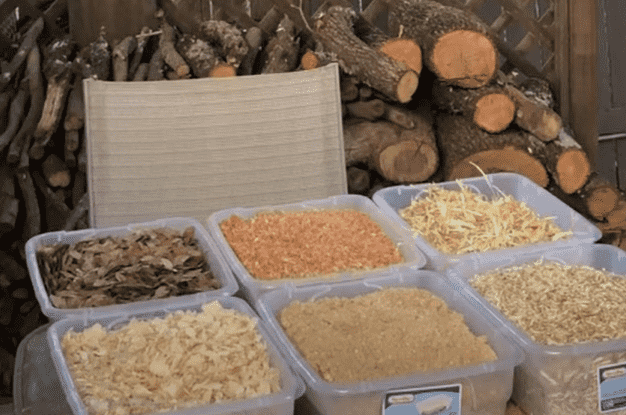How often to change chicken bedding is one of the biggest questions for many chicken coop owners. Whether you are a veteran or a new flock’s owner, everyone needs to shovel their chicken’s bedding out at some point or another. But still, it is not that much talk of the town. This irony is slinkier and more confusing than the uninformed coop owners.
If you don’t frequently change your chicken coop bedding, it will create a smell and expose your flocks to bacteria and mold. Also, later on, your chicken can suffer from respiratory system problems if you leave the dirty bedding in the coop. Changing the bedding frequently will help you to keep your hens disease free and comfortable.
However, thus throughout today’s article, we will explain how often should you clean a chicken coop. Also, we will explain how you can change the bedding and many more things. So, let’s start with the following:
What Are The Best Beddings For Chicken Coops?
There are several bedding options available for your chicken coop. But which one is the best chicken coop bedding? There is much discussion about this issue. This is a burning question because frequent changing may require for few bedding options. While some bedding materials can also last up to 6 months.

Even there is one bedding option that you may require to change only twice a year. However, some of the best bedding options for your chicken coop that will keep the flocks happy, comfy and safe are the following:
- Cedar Shavings
- Excelsior fiber
- Grass Clippings
- Hay
- Hemp
- Mulch
- Pine Needles
- Pine shavings
- Recycled paper
- Rocks
- Sand
- Sawdust
- Shredded cardboard
- Shredded dried leaves
- Straw
How Often To Change Chicken Bedding?
How often you should clean your chicken coop or change the bedding depends on several factors. Some crucial factors are the number of chickens, bedding type, and litter method. However, chicken bedding management mainly is off two types. If you follow the traditional method, you have to change the bedding weekly or daily. And if you adopt the deep litter method, you must change the bedding every six months or yearly.
Some chicken coop owners often ask how frequently they should clean their coop in summer. The answer is to clean the leftover food and water; you should clean the cage daily in summer. And during summer you should clean the poop tray weekly and deep clean the overall coop yearly.

Again many asks about coop cleaning in winter. During winter, you should clean the bedding at least once following the deep-liter method. In contrast, following the traditional way, you have to clean your coop every 2-3 weeks in winter.
So, below, we will discuss the two basic ways of bedding management for your chicken. So, let’s start the discussion:
Classic/Traditional Method
If you use light bedding for your chicken, you must change it frequently, and it’s a money-wasting method. In this bedding management system, depending on your coop and flock’s size, you may need to change the bedding daily or weekly.
In a Normal Litter or traditional method, you have only a few inches of bedding. And thus you require to change it more often. Moreover, the thick bedding layer can’t protect the floor. And therefore, you need to clean the full coop.
Deep Litter Method
This method includes the use of 4-6 inches of organic bedding, which will allow the dust to turn into compost. It is about adding 4-6 inches of bedding in your coop. The greatest benefit of this method is you don’t require to change this bedding frequently.
Every 6 months usually is the bedding changing time. But sometimes for less chicken, you can change the bedding once a year. For making this 4-6 inch bedding, you can use pine shavings or wood shavings.
The wood shavings ensure comfort for your chicken. Also, any poop can’t hit the coop floor if you use wood shavings. However, wood bedding can sometimes be harmful to your chicken. Thus instead of wood, you can also use hemp bedding.
Also Read: How To Choose The Right Materials For A Long-Lasting And Easy-to-Maintain Chicken Coop
How Often Should You Clean A Chicken Coop In Summer?
For deep cleaning your chicken coop, there is no better option than to choose a summer’s sunny day. On a sunny day, the dirt of the chicken dries quickly. Thus just after doing a good spray, the summer weather will put you in a very good mood.

Choosing the best bedding for chicken coops is not enough. You must clean it properly in summer, winter, and other seasons. So if you are concerned about how often you should clean your chicken coop in summer, you can go through the following guide.
- Daily: Every day, you should change the leftover water and food. Especially if you give the food to your chicken in an open container, you should replace it with fresh food. However, you can consider the automatic Waterer or feeders to avoid the daily food-changing option.
- Weekly: To empty the poop tray weekly is really good. Thus using the fresh stuff replaces your coop’s bedding weekly. If you notice the upturned Waterer damage the bedding, you should change the schedule in summer.
- Yearly: Carrying out your coop’s deep clean over the year is advisable. It will probably be better if you do the cleaning every six months. However, deep cleaning in summer is really necessary.
Actually, how frequently you should clean your chicken coop bedding in summer depends on your chicken flock and how grubby they get inside.
How Often To Change Chicken Bedding In Winter?
Following the same rules as above, you can frequently change your chicken coop bedding in winter. However, cleaning the coop at least twice a year is the best practice. Thus at least once, you should change your flock bedding in winter.
Cleaning the coop is not always fun, especially in winter. But it’s the most crucial task, and you can’t let it go. So, at least once, change the bedding in winter. Then, depending on the need, you can change the bedding monthly or weekly in winter.
Money Saving Chicken Bedding Change Ideas
To get your chicken coop inside ready, you require several things. Bedding is one of the most important things. However, frequent changing requires for few chicken bedding options. While a few bedding materials last up to many more days. Some chicken coop bedding requires you to change only twice a year.
Furthermore, the money-saving bedding requires less frequent changing. So, some of the money-saving bedding options are:
- Cedar Shavings
- Excelsior fiber
- Grass Clippings
- Hay
- Hemp
- Mulch
- Pine Needles
- Pine shavings
- Recycled paper
- Rocks
- Sand
- Sawdust
- Straw etc
Frequently Asked Questions
How often should I change the straw in my chicken coop?
You should change your chicken coop’s straw frequently. Of course, the best thing is changing straw every week. But you should not wait more than two weeks to change the straw. Chickens feel comfy and happy in fresh bedding. So you should change the straw bedding frequently.
What is the best bedding for chickens in the winter?
Hemp or pine pellets are absorbent bedding, and these are better bedding options for chickens in the winter. Straw is soft bedding, but the absorbent feature is missing in it. As a result, the straw gets wet quickly, and thus the hens can get sick. So avoid straw bedding in winter.
What’s the warmest bedding for chickens?
For your chickens, one of the warmest bedding options is straw. Warm air gets trapped in the straw’s hollow shafts and feels warm.
Final Thoughts
Hopefully, the above article was quite helpful for you, and now you know how often to change chicken bedding. Actually, how often you should change the bedding depends on different factors, including the number of chickens, bedding type, litter method, etc. But the main thing is you have to change the bedding whenever it becomes dirty to keep your chicken safe and comfortable.
We strongly recommend that every 2-3 weeks, you should change the bedding on your chicken coop. However, to save time and money, you can also use those bedding options which require less frequent changing.
But keep in mind that while choosing the bedding materials for your chicken coop, it shouldn’t be expensive or go to waste. Also, make sure your bedding changes don’t harm the environment.


